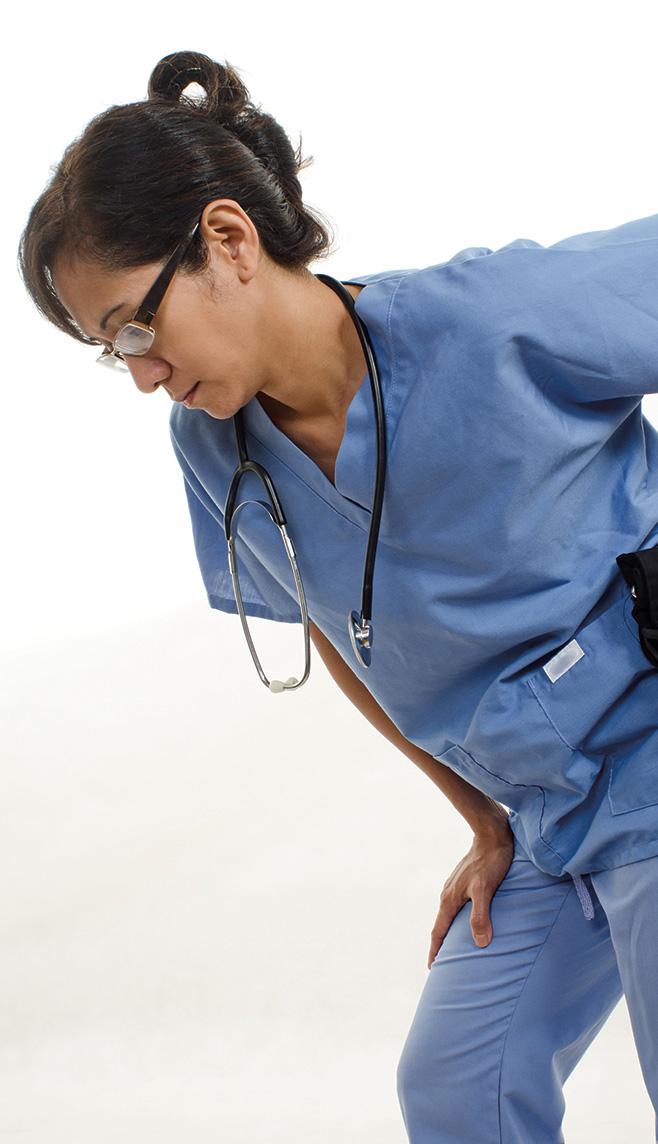Small steps = fewer injuries

NEARLY 90% HAVE NO ACCESS TO SPH EQUIPMENT
Nurses are at risk and are vulnerable to many types of injuries. The most common is musculoskeletal damage due to “overexertion.” For nurses, the main cause of overexertion is the manual lifting, transferring and repositioning of patients. Despite clear empirical evidence that safe patient handling (SPH) equipment dramatically decreases injuries to both healthcare providers and patients and saves millions of dollars for healthcare employers, many healthcare facilities have been slow to implement comprehensive SPH programs. In 2014, New York became the eleventh state to pass a safe patient handling law. The NYS SPH law introduced a somewhat vague, yet ambitious framework for facilities staffed with direct care workers like nurses. So, how do we know if the law has been effective thus far?
NYSNA SPH pilot assessment
NYSNA set out to tackle this question this summer by beginning the first ever “Safe Patient Handling Pilot Assessment Project.” The project focused on four facilities, two private and two public, and tracked their injury rates using the Occupational Safety and Health Administration (OSHA) and Public Employment Safety and Health Bureau (PESH) injury and illness logs over a four-year period. The four facilities included NewYork-Presbyterian (NYP), Westchester Medical Center (WMC), The Brooklyn Hospital Center (TBHC) and Elmhurst Hospital.
In brief, the project showed that when facilities start safe patient handling programs a trend of declining injury rates takes hold. And where SPH programs are not initiated, injuries continue unabated.
As a companion to the project, NYSNA conducted a union-wide health and safety survey. Over 87 percent of respondents to the survey said they had absolutely no safe patient handling equipment. And of those without equipment, 39.7 percent said they had suffered an injury related to patient handling.
What we learned was only the tip of the iceberg. Our preliminary findings highlighted three areas of interest: injury recordkeeping, facility injury rates, and safe patient handling policy.
Our review of patient-handling-related injuries of the four targeted facilities found that the facilities that have implemented, or are well on their way to implementing SPH programs, WMC and NYP, had the lowest incidence rates. While those without an SPH program or in the very beginning stages of implementing a program TBHC and Elmhurst, struggled with significantly higher incidence rates.
For example, in 2016, the patient-handling injury rate for RNs at TBHC was 189 per 10,000, far greater than the 46 per 10,000 rate for all other private sector workplaces nationwide as per the U.S. Bureau of Labor Statistics (the principal federal agency that calculates labor statistics).
Challenges to successful SPH implementation
OSHA and PESH require descriptive, accurate record-keeping of work-related injuries in a facility. However, we found vague language, confusing descriptions and/or blatantly incorrect case-logging. We also discovered crossover between safe patient handling and workplace violence cases. In those instances, a more descriptive record would have been useful in determining how to classify the injury. This led to the question of whether or not the process of injury logging could be improved. Being that these logs are one of the only sources of information we have regarding work-related injuries, poor recordkeeping can severely hamper health and safety monitoring and contribute to the problem of underreporting.
Regardless of the stage of SPH program implementation at each facility, the challenges were the same. Creating and implementing relevant SPH policies presented a significant hurdle. Barriers were grouped into four categories:
- management commitment,
- employee involvement,
- program maintenance,
- hazard identification and control.
Studies suggest that multifaceted programs (ones including equipment, assessment criteria and policies) are the best approach, yet findings suggested this is not yet being achieved. Furthermore, despite there being successful and long-standing programs, such as the Veterans Administration’s Safe Patient Handling & Mobility Program, there is little dialogue between hospital systems regarding best practices. This lack of collaboration is worsened by the “self-certifying” nature of the NYS SPH law. Regardless of how necessary the law is, it still leaves facilities to their own devices by not including any enforcement mechanisms. That makes a study such as this is one extremely important.
SPH advocacy means safer workplaces
Fortunately, we are seeing an upswing in awareness and enthusiasm for continued SPH advocacy. We are also encouraged by our earlier results and are working to confirm that SPH programs prevent injuries. Overall, this project is just the beginning of our journey into assessing the efficacy of the NYS SPH law. What is clear is that more work is needed. Members and facilities need to be informed and further research will do just that.